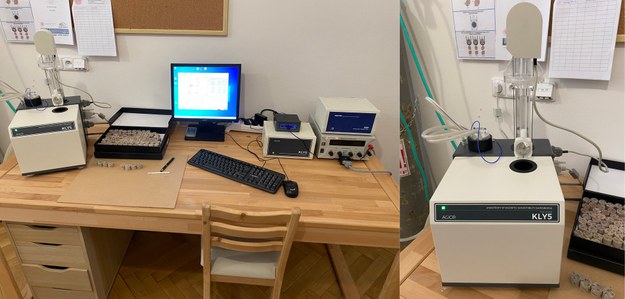Laboratories
The Institute of Geology and Palaeontology incorporates a variety of high-end laboratory facilities which are being extensively used for both research projects and teaching. We also offer analytical services for private companies and external subjects.
Laboratory of Electron Microscopy
The Laboratory of Electron Microscopy is equipped with a JEOL JSM-6380LV scanning electron microscope (made in Japan), which allows analysis of surfaces of inorganic samples, such as fossils, minerals, or rocks at a 10000-fold magnification in both low- and high-vacuum environments. The low-vacuum mode is particularly suitable for the study of biological samples, such as seeds, spores, and cuticles. The Laboratory is also equipped with a JEOL JFC-1200 apparatus for gold coating.
Laboratory of Rock Magnetism

The Laboratory of Rock Magnetism is equipped with all instruments necessary for the sample collection, processing, and measurement of magnetic anisotropy of rocks. The samples are measured on the state-of-the-art KLY5 Kappabridge with additional modules for measuring the temperature dependence of magnetic susceptibility and automatic 3D rotator. This apparatus is currently the most accurate, commercially manufactured instrument of this type in the world, which allows measurements of magnetic susceptibility with extreme accuracy in the order of 10-8. The JR-6A magnetometer along with the LDA5 and PAM1 magnetization and demagnetization units are now available in the laboratory as well. The new apparatus represents the most sensitive and accurate instrument for measuring remanent magnetization of rock and soil samples, based on classical principles (non-quantum and non-cryogenic). These methods are most used in geological sciences for the analysis and quantification of the internal structure, deformation and flow of geological bodies and allow the study of very fine-grained rocks, for which the study of the structure using other conventional methods would be very difficult.
Laboratory of Experimental Tectonics

The laboratory of Experimental Tectonics is equipped with a sophisticated purpose-made apparatus for simulation of subduction and deformation along the convergent plate boundaries, dynamics of accretionary wedges and formation of subduction mélanges. The apparatus was designed and constructed in collaboration with the Czech Academy of Sciences and funded from the University Center of Excellence UNCE/SCI/006.
Laboratory of Optical Microscopy

The Laboratory of Optical Microscopy is equipped with a biological microscope Olympus BX51, allowing objects to be examined in a magnification of 40× to 1000×, an Olympus SZX12 Stereozoom Mikroscope designed especially for incident light with digital camcorder Olympus DP73, and an optical microscope Nikon Eclipse 100LVPol with mounted Canon camera and linked to an image-processing software NIS-Elements D 3.2.
Palaeontological Laboratory
The Palaeontological Laboratory has at its disposal a floating apparatus for separation of different sized fractions of microfossils, a Chemical Laboratory for dissolution of samples and extraction of phosphatic fossils, and a number of other techniques. To visualise palaeontological finds, the Laboratory is equipped with a modern Photo Lab, allowing micro- and macro-scale photography of objects at high resolutions.
Laboratory of 3D geological modeling

The Institute is equipped with 3D geological modeling software package MOVE used for both teaching and research. We use 10 licenses of MOVE including all kinematic and advanced modules. Courtesy of Petroleum Experts Limited., with a total donation of more than 1.8 million of GBP (in year 2024
£1,872,217.38 ).
Document Actions

